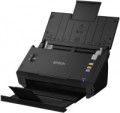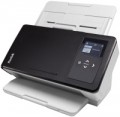Optical element
— CIS, abbreviation for "Contact Image Sensor" — contact image sensor. The simplest type of optical element: it is a line across the entire width of the scanner's working space, on which photocells that read the image and LEDs that provide illumination are located in a row. They are inexpensive and take up little space, which, accordingly, makes the scanners themselves cheaper and smaller. On the other hand,
CIS sensors have a shallow depth of field, and even small bumps in the scanned image can be out of focus. However, in general, they are quite suitable for both personal and not too complex professional tasks.
— CCD, short for "Charge-Coupled Device" — a charge-coupled device. A much more complex design than CIS, includes a fluorescent lamp, lens and mirror.
CCD scanners are larger, heavier and much more expensive than their counterparts in CIS. On the other hand, this type of optical element provides high-quality colour reproduction and a good depth of field, coping well with complex-shaped media. Therefore, advanced professional scanners are usually equipped with a CCD.
— CMOS. The abbreviation for "Complementary Metal-Oxide-Semiconductor" is a complementary metal-oxide-semiconductor structure (the designation CMOS is also used in Russian). A key feature
of CMOS sensors is that they capture the scanned image as a whole, similar to photography (and not
...line by line, as in other types of optical elements). In fairness, it should be noted that the "instantaneous" scanning does not give a tangible advantage in speed, because. processing the captured image takes quite a long time. However, this feature is extremely useful in cases where it is difficult to ensure the immobility of the scanned material and/or uniform movement of the optical element relative to this material. Such situations often arise when working with book and handheld scanners (see "Type"), so CMOS elements are most popular in such devices.Max. scan area
The maximum image size that the scanner can process at one time, both horizontally and vertically. You should pay attention to this parameter if you need the exact dimensions of the scanner's working area, down to a millimetre: although standard formats are used to designate these dimensions (see "Format"), in fact the dimensions may differ from them.
Shades of grey
The number of shades of grey that the scanner recognizes. You should pay attention to this parameter if you plan to actively work with complex black-and-white materials (for example, photographs) — the more shades, the higher the quality of the digitized image. To date, the average is considered to be 512 shades — this approximately corresponds to the capabilities of the human eye. Models with a lower indicator belong to the entry level, more advanced ones “understand” 1024 shades.
Duplex scanning
Availability of
duplex scanning function in the device. Duplex scanning in this case means such an operating mode in which the scanner simultaneously captures an image from both sides of the processed medium (sheet of paper). The convenience of this feature is obvious: the media does not have to be turned over to scan each side separately, and the processing time is significantly reduced. Double-sided scanning is found mainly in the models of traction or combined type (see above), however, there are also flatbed scanners with this capability.
Data transfer
— Wi-Fi. A wireless interface primarily used to build local computer networks. In many respects it is similar to the LAN described below (in particular, it allows using the scanner as a network device), but it compares favorably due to the absence of a cable and the ability to work directly through walls. In addition, relatively recently, Wi-Fi modules have appeared with the ability to directly connect between devices — for example, to control a scanner from a tablet and transfer processed materials to the tablet directly, without creating a computer network. However
scanners with Wi-Fi are quite expensive.
—
USB. Universal interface for connecting various peripherals to a computer, including scanners. Today, it is the most common port of this type; at least one USB input is provided by the vast majority of PCs and laptops.
—
SCSI. Universal interface for connecting computer peripherals; has a good speed, however, it is much less common than its analogues, besides it is considered obsolete and is gradually being replaced by other standards.
—
IEEE-1394. Universal port, in many ways similar to USB (see above). Provides higher speed than the most common USB 2.0, but is much less common.
-LAN. Connector for connecting various devices to a local computer network. A scanne
...r with this interface can be connected as a network device and used with it by any computer on the network, which can be especially useful in offices.LCD screen
The scanner has its own
display. Such displays can vary from simple indicators that display a minimum of service information (selected mode, work process, some errors, etc.) to full-colour touch screens that significantly expand the capabilities of the device. Anyway, the display makes the operation of the scanner more convenient and intuitive.
Noise level
The maximum noise level produced by the scanner during operation. Theoretically, the lower this parameter, the more comfortable the use of the device, however, the vast majority of scanners have a noise level much lower than the general sound background in a small office (this background is 40-50 dB). Therefore, it is worth paying special attention to the noise level if you plan to use the device at home at a later time, or in other environments where even a slight noise may be undesirable.
Power consumption
The maximum power consumed by the scanner during operation. The higher the power, the more energy the scanner consumes, but this only applies to the scanning process itself — in standby mode, power consumption is negligible. And even at the peak in most models, the power is so low that in fact this parameter has practically no effect on electricity bills and is more of an auxiliary value (for example, it is used to calculate the total power of devices connected to an uninterruptible power supply).

